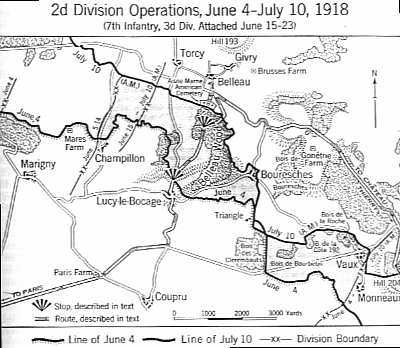The Story of the American Expeditionary Forces |
 U.S. Marine Corps |
THE GERMAN DEFENSIVE PLAN
|


By SSgt Dieter Stenger, USMC, Ordnance Unit, Air-Ground Museum, Quantico
Following the remarkable success of the German surprise attack of 27 May 1918 on the Chemin des Dames that effectively threatened the fall of Paris and caused great panic within the French capital, French Forces abandoned their positions and left the American Expeditionary Force to hold a thin and overextended line. The German success in the Paris sector was not, however, anticipated by the German High Command, with the bulk of their strength lying in the north opposite the British where they planned to renew the attack with reserve forces. Unable to exploit their unexpected break-through towards Paris, the Germans called for a general halt once they reached the line held by the Marines.
Under orders of the French corps commander, Allied troops began a general advance on 6 June to secure better positions. In conjunction with French Forces, the 5th and 6th Marine Regiments moved into position for the attack. On the far left of the Marine Brigade, the first advance began with elements of the 1st Battalion, 5th Marines, under the command of Major Julius S. Turrill. With this action representing the first Marine attack in France, Turrill made gains in the north by advancing 1,000 yards along an 800-yard front, supported by divisional artillery and a company of the Marine 6th Machine Gun Battalion, under the command of Major Edward B. Cole. The next attack would be launched against the German positions in Belleau Wood.
The first Marine attack proved to go well against the Germans, thus leaving them in a salient at Lucy-le-Bocage. Marshal Ferdinand Foch, the Allied commander, ordered the salient reduced as Marines made plans to attack against Belleau Wood and Bouresches, thereby straightening the front line along the northeast edge of Belleau Wood.

Belleau Wood was approximately one mile in length and consisted of thick, heavily wooded terrain, cut by a deep ravine at the southern end, and spotted with large, sporadic boulders. These terrain features made excellent machine gun and trench mortar positions that provided excellent protection for entrenched infantry. The German positions at Belleau Wood were held by the 461st Infantry Regiment, 237th Division, at a strength of 1,169 men and auxiliary troops.
Two battalions held the defensive lines, and one was placed in reserve, within the wood, and additional support was provided by protective artillery barrages. The Germans' main line of resistance curved to the southeast, with three lines of trenches, turning Belleau Wood into a massive machine gun nest. The first trench line faced the villages of Lucy-le-Bocage and Bouresches from the southern edge. It was a natural fortress high on a plateau, scored with brush-filled ravines. Among the huge mossy boulders, 15 heavy machine guns were emplaced so as to provide themselves with interlocking fields of fire. If one were captured, the others could immediately expose it to flanking fire. The second line of trenches ran from east to west through the center of the wood. Protected by a line of barbed wire, trench mortars, and sharpshooters, this portion of the defensive line had trees that stood so close together that visibility was reduced to 15 feet or less. The third and final trench line, the strongest of them all, ran across the northern edge of the wood. In addition to the barbed wire and trench mortars, the avenues of approach were registered and covered by artillery batteries located behind the village of Torcy. The sum of machine guns emplaced in and along the edge of Belleau Wood, against which the Marines would attack, totaled nearly 200. Although the German troops were well-armed and seasoned veterans, their stamina was poor due to food rationing and sickness.
The Marine attack advanced in "line of sections," a standard French formation that was, by now, well rehearsed by the Marines. This formation provided that each company formed a two-platoon front, with two platoons supporting. Each platoon was divided into four sections, with two sections forward and spaced about 40 yards apart from the two remaining in the rear proper. As the attack began, Major Turrill ordered his men to "move out" after a short artillery barrage and preparatory machine gun fire. Capt George Hamilton, leading a company of Marines through a wheat field that sloped gently upward toward a patch of trees remarked:
We hadn't gone fifty yards when they cut loose at us from the woods ahead-more machine guns than I had ever heard before. I have a vague recollection of urging the whole line on-faster, perhaps, than they should have gone, . . . shooting wildly at several retreating Boche (Germans). Farther on we came to an open field, a wheat field full of red poppies, and here we caught hell. Again it was a case of rushing across the open and getting to the woods.
 |
This article was first published in the Winter 97-98 edition of Fortitude: Bulletin of the Marine Corps Historical Program
To find other Doughboy Features visit our |
Membership Information  Click on Icon |
For further information on the events of 1914-1918
visit the homepage of |
Michael E. Hanlon (medwardh@hotmail.com) regarding content,
or toMike Iavarone (mikei01@execpc.com) regarding form and function.
Original artwork & copy; © 1998-2000, The Great War Society